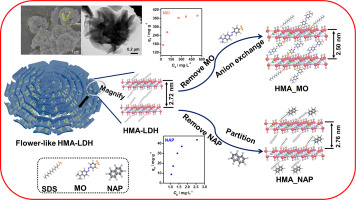当前位置:
X-MOL 学术
›
Appl. Clay. Sci.
›
论文详情
Our official English website, www.x-mol.net, welcomes your feedback! (Note: you will need to create a separate account there.)
Persistent organic pollutants removal via hierarchical flower-like layered double hydroxide: Adsorption behaviors and mechanism investigation
Applied Clay Science ( IF 5.6 ) Pub Date : 2020-04-01 , DOI: 10.1016/j.clay.2020.105500 Zebing Zhu , Sida Ouyang , Peng Li , Lili Shan , Ruonan Ma , Ping Zhang
Applied Clay Science ( IF 5.6 ) Pub Date : 2020-04-01 , DOI: 10.1016/j.clay.2020.105500 Zebing Zhu , Sida Ouyang , Peng Li , Lili Shan , Ruonan Ma , Ping Zhang

|
Abstract Nanostructured hierarchical flower-like MgAl layered double hydroxide (HMA-LDH) was synthesized via the one-pot soft-template method and employed for the adsorption of persistent organic pollutants: anionic methyl orange (MO) and non-ionic naphthalene (NAP). The adsorption performance and mechanism comparison of MO and NAP were investigated via adsorption kinetics, isotherms, thermodynamics, and microstructural characterization. The maximum adsorption capacity of MO and NAP could reach 380.2 and 43.7 mg·g−1 at 298 K, respectively. The kinetic studies illustrated that the adsorption equilibria reached in 2 and 1 h for MO and NAP, respectively. The adsorption isotherms indicated that HMA-LDH fitted the Langmuir model toward MO removal, while partition model for NAP. The comparative mechanism between MO and NAP were determined by X-ray diffraction (XRD), Fourier transform spectroscopy (FTIR), and X-ray photoelectron spectroscopy (XPS). Anion exchange dominated the MO adsorption, whereas partition was deemed as the predominated mechanism for NAP. Furthermore, the recycle performance stated that HMA-LDH could be reused in five cycles in MO adsorption, while failed after two cycles for NAP. This study provided a theoretical foundation for the practical application of hierarchical flower-like LDH in the adsorption of persistent organic pollutants in the aquatic environment.
中文翻译:

分层花状层状双氢氧化物去除持久性有机污染物的吸附行为与机理研究
摘要 通过一锅软模板法合成了纳米结构分层花状MgAl层状双氢氧化物(HMA-LDH),用于吸附持久性有机污染物:阴离子甲基橙(MO)和非离子萘(NAP) . 通过吸附动力学、等温线、热力学和微观结构表征研究了 MO 和 NAP 的吸附性能和机理比较。MO和NAP的最大吸附容量在298 K时分别达到380.2和43.7 mg·g-1。动力学研究表明,MO 和 NAP 的吸附平衡分别在 2 小时和 1 小时内达到。吸附等温线表明 HMA-LDH 符合 Langmuir 模型,适用于 MO 去除,而分配模型适用于 NAP。MO和NAP之间的比较机制通过X射线衍射(XRD)、傅里叶变换光谱(FTIR)和X射线光电子能谱(XPS)确定。阴离子交换主导 MO 吸附,而分配被认为是 NAP 的主要机制。此外,循环性能表明 HMA-LDH 可以在 MO 吸附中重复使用 5 个循环,而 NAP 在两个循环后失效。该研究为分级花状LDH在水环境中持久性有机污染物吸附中的实际应用提供了理论基础。循环性能表明 HMA-LDH 可以在 MO 吸附中重复使用 5 个循环,而 NAP 在两个循环后失败。该研究为分级花状LDH在水环境中持久性有机污染物吸附中的实际应用提供了理论基础。循环性能表明 HMA-LDH 可以在 MO 吸附中重复使用 5 个循环,而 NAP 在两个循环后失败。该研究为分级花状LDH在水环境中持久性有机污染物吸附中的实际应用提供了理论基础。
更新日期:2020-04-01
中文翻译:

分层花状层状双氢氧化物去除持久性有机污染物的吸附行为与机理研究
摘要 通过一锅软模板法合成了纳米结构分层花状MgAl层状双氢氧化物(HMA-LDH),用于吸附持久性有机污染物:阴离子甲基橙(MO)和非离子萘(NAP) . 通过吸附动力学、等温线、热力学和微观结构表征研究了 MO 和 NAP 的吸附性能和机理比较。MO和NAP的最大吸附容量在298 K时分别达到380.2和43.7 mg·g-1。动力学研究表明,MO 和 NAP 的吸附平衡分别在 2 小时和 1 小时内达到。吸附等温线表明 HMA-LDH 符合 Langmuir 模型,适用于 MO 去除,而分配模型适用于 NAP。MO和NAP之间的比较机制通过X射线衍射(XRD)、傅里叶变换光谱(FTIR)和X射线光电子能谱(XPS)确定。阴离子交换主导 MO 吸附,而分配被认为是 NAP 的主要机制。此外,循环性能表明 HMA-LDH 可以在 MO 吸附中重复使用 5 个循环,而 NAP 在两个循环后失效。该研究为分级花状LDH在水环境中持久性有机污染物吸附中的实际应用提供了理论基础。循环性能表明 HMA-LDH 可以在 MO 吸附中重复使用 5 个循环,而 NAP 在两个循环后失败。该研究为分级花状LDH在水环境中持久性有机污染物吸附中的实际应用提供了理论基础。循环性能表明 HMA-LDH 可以在 MO 吸附中重复使用 5 个循环,而 NAP 在两个循环后失败。该研究为分级花状LDH在水环境中持久性有机污染物吸附中的实际应用提供了理论基础。


























 京公网安备 11010802027423号
京公网安备 11010802027423号